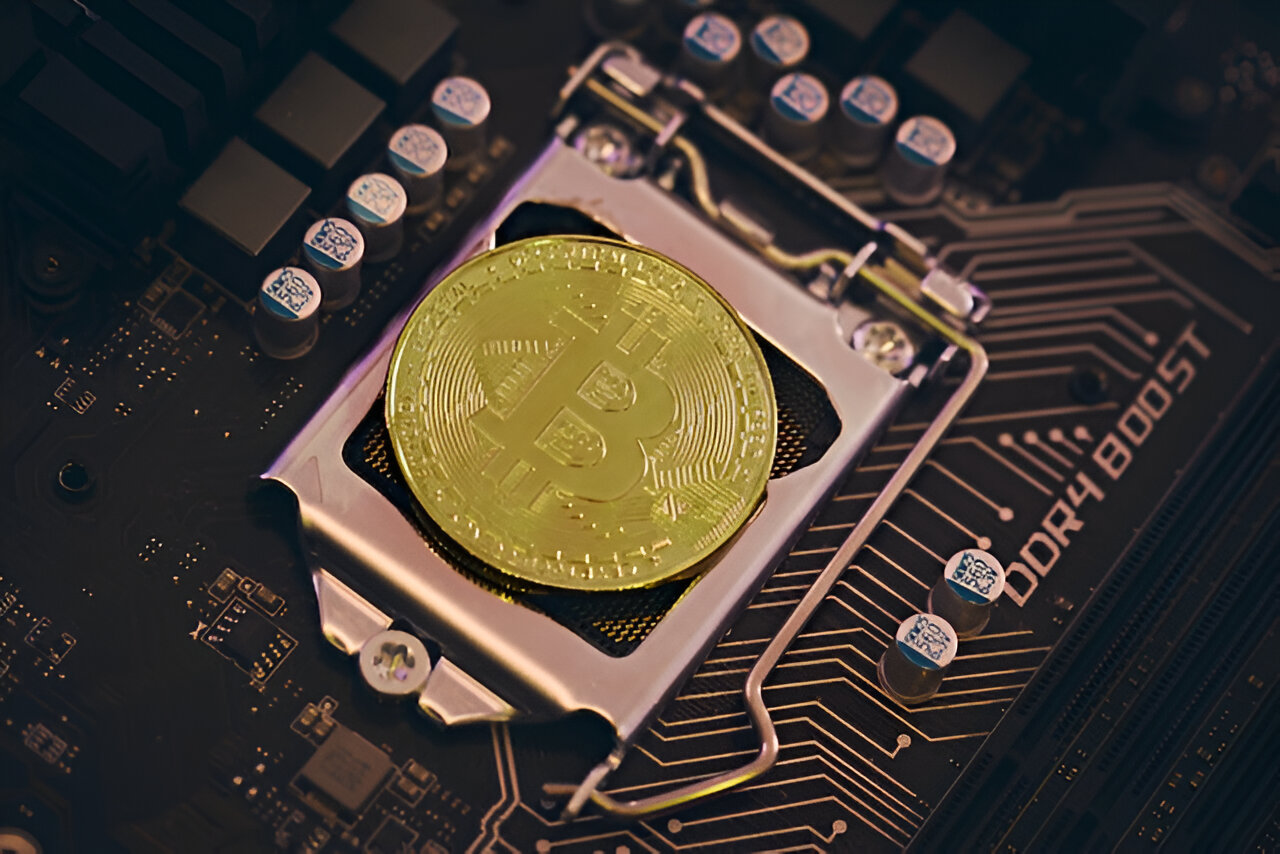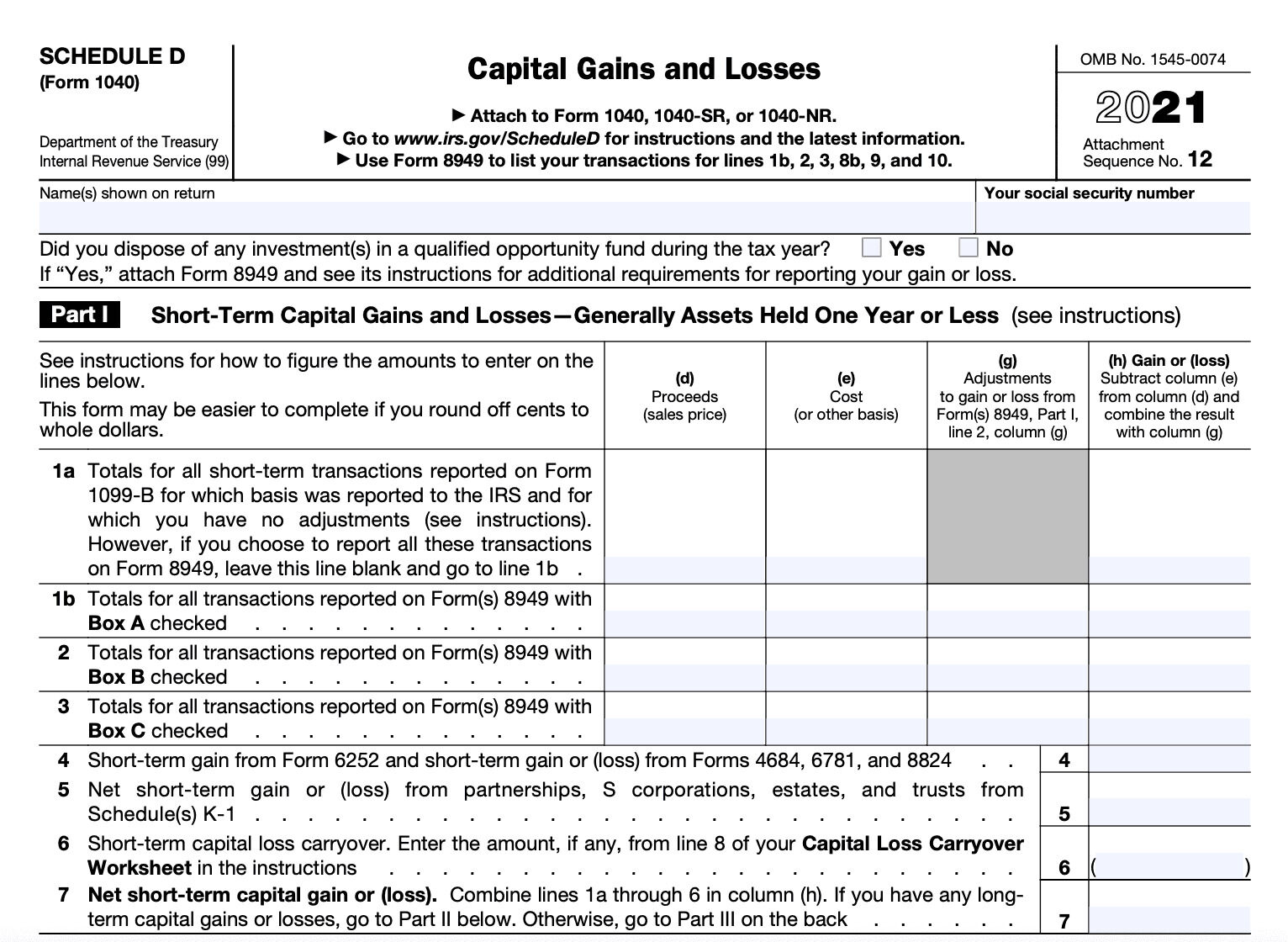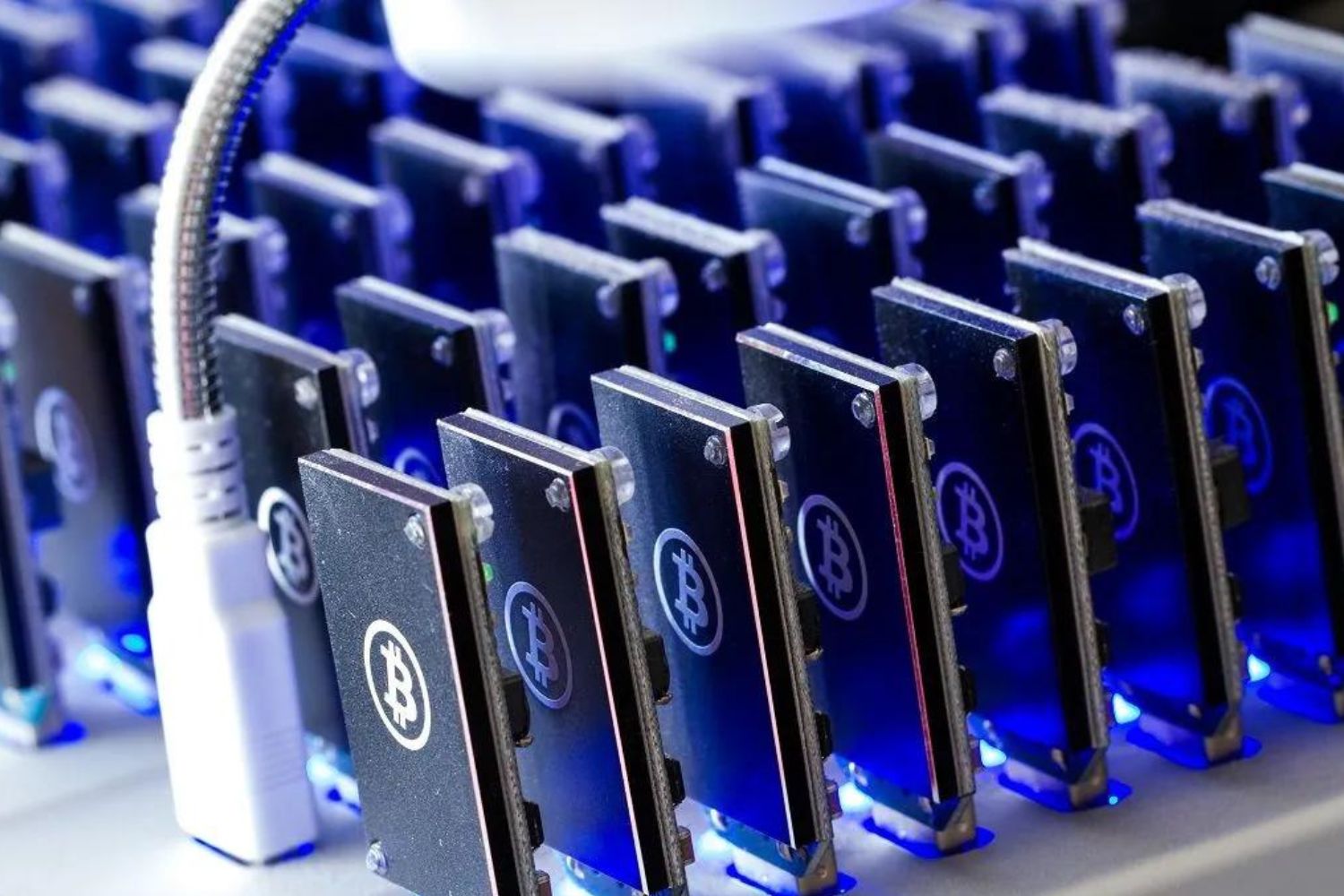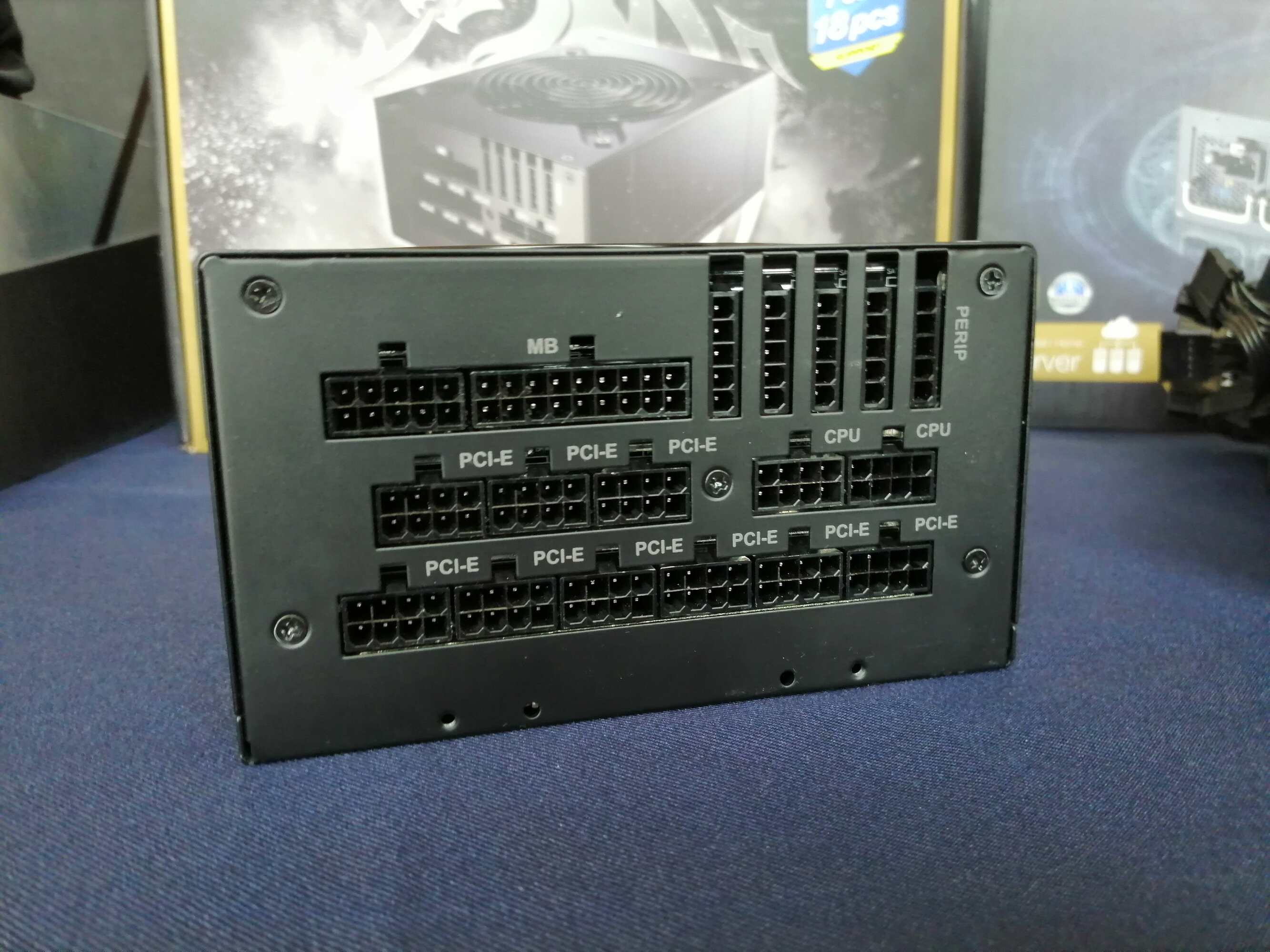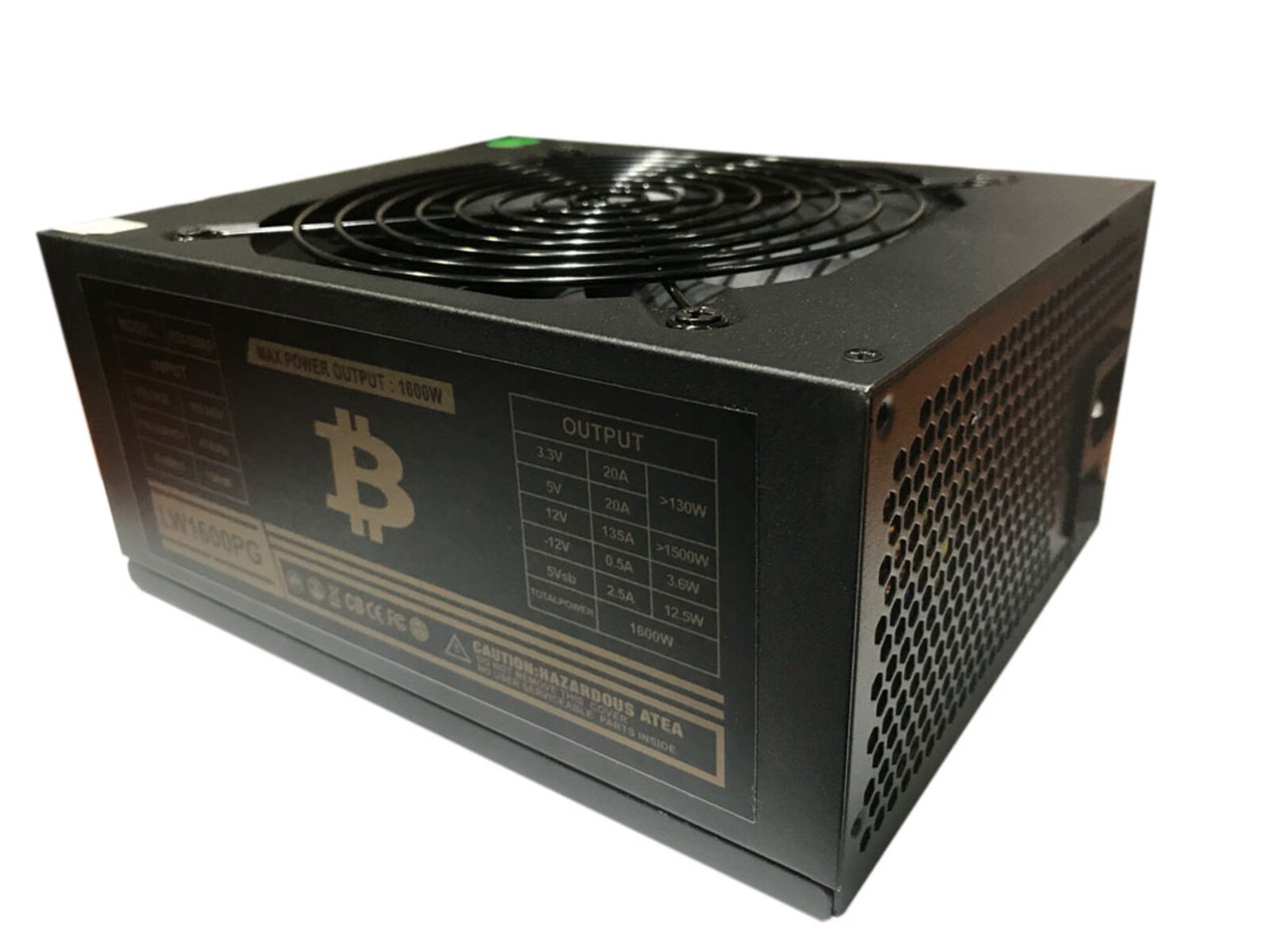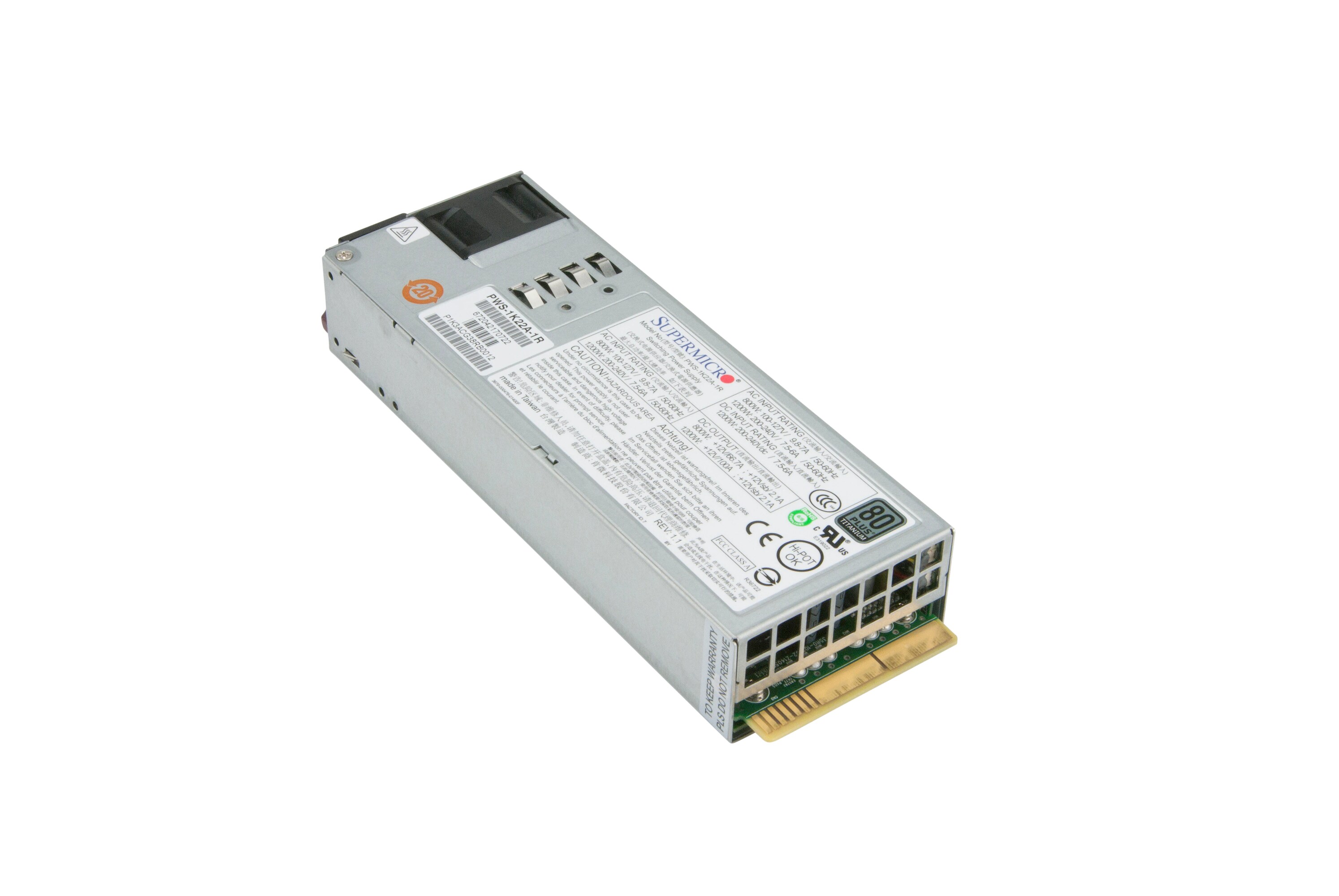Introduction
Welcome to the world of Bitcoin mining! With the rise in popularity and value of cryptocurrencies, many individuals are interested in exploring the possibility of mining Bitcoin from the comfort of their own homes. Bitcoin mining is the process of validating and verifying transactions on the Bitcoin network, as well as adding them to the blockchain, the public ledger of all Bitcoin transactions.
But before you delve into the world of Bitcoin mining, it’s important to have a clear understanding of how it works and what you’ll need to get started. In this guide, we will walk you through the process of setting up your own Bitcoin mining rig, choosing the right hardware, installing and configuring mining software, joining a mining pool, and optimizing your mining performance.
Bitcoin mining is not a get-rich-quick scheme, as it requires a significant investment of time, money, and resources. However, with the right setup and approach, it can be a rewarding and profitable endeavor. Whether you’re a tech enthusiast looking to explore the world of cryptocurrencies or an investor looking to diversify your portfolio, understanding the basics of Bitcoin mining will equip you with the knowledge to make informed decisions.
In this comprehensive guide, we’ll cover everything you need to know to start mining Bitcoin at home. From choosing the right hardware to troubleshooting common issues, we’ll provide you with the step-by-step instructions and insights to ensure a successful mining experience.
Before we dive into the technical aspects, it’s important to note that the landscape of Bitcoin mining is constantly evolving. The difficulty level of mining, as well as the profitability, can fluctuate due to various factors such as market conditions, network congestion, and the introduction of new mining technologies. It’s essential to stay informed and adapt your mining strategy accordingly.
Now, let’s get started on our journey to mine for Bitcoin at home!
Understanding Bitcoin Mining
Bitcoin mining is the process by which new bitcoins are created and transactions are verified and added to the blockchain. It is a crucial component of the Bitcoin network, ensuring the security and integrity of the decentralized digital currency.
At its core, Bitcoin mining involves solving complex mathematical problems using powerful hardware devices called mining rigs. These rigs perform numerous calculations per second to find a specific hash value that meets the requirements set by the Bitcoin protocol. The first miner to find the correct hash is rewarded with newly minted bitcoins.
The process of mining serves two primary functions:
- Transaction Verification: Miners validate and confirm transactions by including them in blocks, which are then added to the blockchain. This verification process ensures that each transaction is legitimate and prevents double-spending.
- Bitcoin Creation: As a reward for their efforts in securing the network and validating transactions, miners are given a certain amount of newly created bitcoins. This serves as an incentive to encourage miners to contribute their computational power.
Bitcoin mining uses a Proof of Work (PoW) consensus algorithm, which requires miners to provide proof that they performed a certain amount of computational work. The difficulty of the mathematical problems that need to be solved adjusts regularly to ensure that new blocks are added to the blockchain approximately every 10 minutes.
Over time, the process of mining has become increasingly competitive and resource-intensive. Earlier, it was possible to mine bitcoins using a standard computer or laptop, but today, specialized mining hardware known as ASICs (Application-Specific Integrated Circuits) is necessary to compete effectively.
Although Bitcoin mining can seem complex, especially for beginners, it is essential to note that you don’t need to fully understand the technical intricacies to start mining. However, having a basic understanding of the main concepts will help you make informed decisions and navigate the world of Bitcoin mining effectively.
In the next section, we’ll delve into the process of setting up a Bitcoin mining rig, including choosing the right hardware and installing the necessary software.
Setting Up a Bitcoin Mining Rig
To mine for Bitcoin at home, you’ll first need to set up a mining rig. This includes selecting the right hardware components, installing and configuring the mining software, and connecting to a mining pool. Here’s a step-by-step guide to help you get started:
- Choosing the Right Hardware: The heart of your mining rig is the ASIC (Application-Specific Integrated Circuit) miner. It is specifically designed to mine Bitcoin and offers significantly higher hash rates compared to traditional CPUs or GPUs. Research different ASIC models, considering factors such as price, power consumption, and hash rate, to find the most suitable one for your mining needs.
- Setting Up the Mining Software: Once you have the hardware, you’ll need to install and configure the mining software. The software connects your mining rig to the Bitcoin network, allowing it to participate in the mining process. Popular mining software options include CGMiner, BFGMiner, and EasyMiner. Consult the software’s documentation for instructions on installation and configuration.
- Joining a Mining Pool: While it is possible to mine Bitcoin solo, joining a mining pool is often recommended for small-scale miners. Mining pools combine the computational power of multiple miners to increase the chances of finding a block and earning a reward. Research and choose a reputable mining pool that aligns with your goals and offers competitive fees.
- Configuring the Mining Pool: Once you’ve selected a mining pool, you’ll need to create an account and configure your mining software to connect to the pool. The mining pool will provide you with specific connection details that you’ll need to enter in the software’s configuration settings. This allows your rig to contribute its hash power to the pool and receive a share of the rewards.
- Optimizing Your Mining Performance: Once your mining rig is up and running, you can optimize its performance to maximize your mining efficiency. This includes adjusting the mining software settings, such as fan speed and voltage, to achieve optimal performance without overheating the hardware. Regularly monitor your rig’s temperature, hashrate, and power consumption to ensure smooth operation.
It’s important to note that setting up a mining rig requires a dedicated space with proper ventilation and cooling to prevent overheating. Additionally, you should consider the electricity costs and the noise generated by the mining rig. It’s advisable to calculate the expected profitability and conduct a cost-benefit analysis before investing in mining hardware.
Now that you have a basic understanding of setting up a Bitcoin mining rig, the next section will cover the importance of choosing the right hardware for your mining operations.
Choosing the Right Hardware
When it comes to Bitcoin mining, selecting the right hardware is crucial for maximizing your mining efficiency and profitability. The primary hardware component you’ll need is an ASIC (Application-Specific Integrated Circuit) miner, specifically designed to mine Bitcoin. Here are some factors to consider when choosing the right hardware:
- Hash Rate: The hash rate refers to the computational power of the miner, measured in hashes per second (H/s) or terahashes per second (TH/s). A higher hash rate means more calculations can be performed, leading to a greater chance of earning mining rewards. Consider the current network difficulty and the anticipated increase in difficulty over time when selecting a miner with an appropriate hash rate.
- Energy Efficiency: Mining Bitcoin requires a significant amount of electricity, so energy efficiency is a crucial factor to consider. Look for miners that offer a high hash rate while consuming the least amount of power. Energy-efficient miners will help keep your electricity costs low and increase your profitability.
- Price: The cost of the mining hardware is an important consideration, as it directly influences your initial investment and potential return on investment. Research different models and compare their prices, factoring in the hash rate and energy efficiency to find a balance between affordability and performance.
- Reliability: Choose hardware from reputable manufacturers with a track record of producing reliable and durable mining equipment. You want a miner that can operate continuously without frequent breakdowns or malfunctions, as any downtime can result in lost mining opportunities and reduced profitability.
- Manufacturer Support: Consider the level of support provided by the manufacturer for the hardware you choose. Reliable customer support and regular firmware updates can help address any technical issues that may arise and ensure that your mining operation runs smoothly.
It’s important to note that the Bitcoin mining hardware market is constantly evolving, with new models and technologies being introduced regularly. Stay updated with the latest releases and reviews to make an informed decision about which hardware to purchase.
Once you’ve chosen your ASIC miner, ensure that you purchase it from a reputable source to avoid scams or receiving counterfeit hardware. Research the seller’s reputation and verify their authenticity before making a purchase.
Lastly, it’s worth considering the scalability of your mining operation. If you plan to expand your mining activities in the future, choose hardware that allows for easy integration and additional units to be added to your setup.
Choosing the right hardware is a crucial step in setting up your Bitcoin mining rig. In the next section, we’ll explore the process of installing and configuring the mining software on your chosen hardware.
Installing and Configuring Mining Software
Once you have your mining hardware ready, the next step is to install and configure the mining software. The mining software allows your hardware to communicate with the Bitcoin network, participate in the mining process, and contribute its computational power. Here’s a step-by-step guide to help you get started:
- Choose Mining Software: There are various mining software options available, each with its own features and compatibility. Popular choices include CGMiner, BFGMiner, and EasyMiner. Research and select a mining software that is compatible with your operating system and supports your mining hardware model.
- Download and Install: Once you have chosen the mining software, visit the official website or a trusted source to download the installation file. Follow the installation instructions provided by the software developer to install the mining software on your computer.
- Configuration: After the installation is complete, you’ll need to configure the mining software to connect it to the Bitcoin network and your mining pool. Open the software and locate the configuration settings, which are typically found in a configuration file or through the software’s graphical user interface.
- Pool Connection: To connect your mining software to a mining pool, you’ll need to enter the pool’s connection details. These details usually include the pool’s URL, port number, username, and password. Consult the documentation provided by your mining pool to obtain the correct connection information.
- Wallet Address: Additionally, you’ll need to provide your Bitcoin wallet address to the mining software. This is where you’ll receive your mining rewards. If you don’t have a wallet, create one by choosing a reputable wallet provider and following their instructions for generating a wallet address.
- Tweaking Settings: Depending on your hardware and the mining software you choose, you may have access to additional settings that allow you to optimize the performance of your mining rig. These settings can include adjusting fan speed, voltage, and clock speed. Experiment with different settings to find the optimal configuration for your hardware.
It’s important to note that each mining software has its own configuration requirements and settings. Consult the software’s documentation or online resources for detailed guidance on configuring the mining software for optimal performance.
Once you have successfully installed and configured the mining software, you are ready to start mining for Bitcoin. Remember to regularly monitor your mining operation and adjust settings as needed to ensure efficient and stable performance.
In the next section, we will discuss the benefits of joining a mining pool and how it can enhance your mining experience.
Joining a Mining Pool
Joining a mining pool is a popular choice for Bitcoin miners, especially for those who have limited resources or prefer a more consistent mining income. Mining pools are groups of miners who combine their computational power to increase the chances of finding a block and earning a reward. Here are the key benefits of joining a mining pool:
- Increased Chances of Earning Rewards: By pooling resources with other miners, your collective hash power increases, improving your chances of successfully mining a block. When a block is mined, the rewards are distributed among pool members based on their contribution. This allows you to earn a steady income, even with a relatively small mining rig.
- Consistent and Stable Payouts: Mining on your own can be unpredictable, as the time between finding blocks can vary greatly. Joining a mining pool ensures a more consistent payout, as the pool finds blocks more frequently. This stability can provide a steady income stream to support your mining operation.
- Reduced Variance: Bitcoin mining is subject to variance, meaning that the mining rewards can fluctuate significantly from block to block. By joining a mining pool, you reduce the impact of variance, making your mining rewards more predictable and stable over time.
- Access to Professional Support: Mining pools often provide support and guidance to their members. Pool operators can assist with any technical issues and provide insights into optimizing your mining performance. This support can be invaluable, especially for beginners in the mining space.
- Networking and Learning Opportunities: Joining a mining pool allows you to connect and interact with other miners in the community. You can exchange knowledge, share experiences, and learn from more experienced miners to improve your mining skills and stay updated on the latest industry trends.
When selecting a mining pool, consider factors such as fees, payout methods, pool size, and reputation. Look for pools that have a good track record, offer competitive fees, and have a low percentage of rejected shares. It’s also advisable to choose a pool with servers geographically close to you to reduce latency and improve mining efficiency.
Once you’ve chosen a mining pool, you’ll need to create an account on the pool’s website. This account will be used to monitor and manage your mining activity. Most pools provide detailed guides or even dedicated software to help you configure your mining software to connect to the pool.
By joining a mining pool, you can enhance your mining experience and increase your chances of earning a steady income from Bitcoin mining. In the next section, we’ll explore the concept of mining difficulty and its effects on the mining process.
Understanding Mining Difficulty
Mining difficulty plays a crucial role in the Bitcoin mining ecosystem. It adjusts regularly to maintain a consistent block time of approximately 10 minutes. Understanding mining difficulty is essential for miners to gauge the level of competition and plan their mining strategies. Here’s a closer look at mining difficulty and its effects on the mining process:
What is Mining Difficulty?
Mining difficulty refers to the measure of how hard it is to find a hash value that meets the requirements set by the Bitcoin protocol. The difficulty is adjusted every 2,016 blocks, or roughly every two weeks, based on the total computational power of the network. The aim is to ensure that new blocks are added to the blockchain at a consistent rate.
How is Mining Difficulty Adjusted?
The adjustment of mining difficulty is performed using a mathematical formula known as the Difficulty Adjustment Algorithm (DAA). The DAA takes into account the total hash rate of the network during the previous difficulty period and makes adjustments to increase or decrease the difficulty level accordingly.
The Impact of Mining Difficulty on Miners
As mining difficulty increases, it becomes harder for miners to find a hash that meets the required criteria. This means that more computational power is required to mine new blocks, leading to an increase in the overall competition among miners. Miners with older or less efficient hardware may find it more challenging to remain profitable.
Conversely, when mining difficulty decreases, it becomes easier to find a valid hash, and less computational power is required. This can benefit miners using older hardware or those operating in regions with lower electricity costs, as they have a higher chance of mining blocks and earning rewards.
The Relationship Between Mining Difficulty and Network Hash Rate
Mining difficulty is directly tied to the network hash rate—the total computational power of all miners on the Bitcoin network. When more miners join the network and contribute their hash power, the overall network hash rate increases, leading to a higher mining difficulty. Conversely, if miners leave the network or reduce their hash power, the network hash rate decreases, resulting in a lower mining difficulty.
It’s important to note that mining difficulty adjustments aim to maintain a relatively stable block time, regardless of changes in the network’s hash rate. This ensures a consistent issuance of new bitcoins and keeps the overall supply in line with the protocol’s design.
The Future of Mining Difficulty
As more miners and mining hardware join the network, the mining difficulty will continue to increase. It’s essential for miners to stay informed about the latest trends and advancements in mining technology to remain competitive. Regularly assessing mining difficulty and adjusting mining strategies accordingly will help miners navigate the changing landscape and maintain profitability.
In the next section, we will discuss the importance of monitoring and optimizing mining performance for efficient and successful Bitcoin mining.
Monitoring and Optimizing Mining Performance
Monitoring and optimizing your mining performance is crucial for staying efficient and maximizing your chances of earning rewards in Bitcoin mining. By regularly assessing and fine-tuning your mining operation, you can improve your hash rate, reduce downtime, and increase profitability. Here are some key considerations for monitoring and optimizing your mining performance:
Regular Monitoring:
Monitoring your mining operation is essential to identify any issues or anomalies that may impact your performance. Keep track of key metrics such as hash rate, temperature, power consumption, and accepted/rejected shares. Analyze the data and look for patterns or discrepancies that may indicate hardware failure, cooling problems, or software configuration issues.
Optimizing Hardware Configuration:
Adjusting the settings of your mining hardware can significantly impact your mining performance. Experiment with different fan speeds, voltage settings, and clock speeds to find the optimal configuration for your specific hardware. Be cautious when making changes and monitor the impact on temperature and stability to ensure proper functioning.
Software Optimization:
Stay updated with the latest version of your mining software and firmware. Developers often release updates to improve performance, fix bugs, and introduce new features. Follow the software’s official channels and community forums to stay informed about any optimizations or enhancements that can benefit your mining operation.
Internet Connectivity:
A stable and reliable internet connection is crucial for uninterrupted mining. Ensure that you have a high-speed connection with low latency to the mining pool. Consider using a wired connection instead of relying on Wi-Fi, as it provides a more consistent and reliable connection. Regularly check your internet speed to ensure it meets the requirements of your mining operation.
Monitoring Energy Consumption:
Electricity costs can significantly impact your mining profitability. Monitor your energy consumption and calculate the expenses accordingly. Consider optimizing your hardware settings, such as undervolting, to reduce power consumption without sacrificing performance. Additionally, explore ways to lower your overall electricity costs, such as taking advantage of off-peak electricity rates or using renewable energy sources.
Security Considerations:
Ensure that your mining operation is secure from external threats. Use reputable mining software and keep it updated to protect against potential vulnerabilities. Implement strong passwords and two-factor authentication for your mining pool and wallet accounts. Regularly scan your mining rig for malware or malicious software that could compromise your security and mining performance.
By continually monitoring and optimizing your mining performance, you can maintain a competitive edge in the ever-evolving world of Bitcoin mining. Regularly assess your settings, hardware performance, and network conditions to make informed decisions that enhance your mining efficiency and profitability.
In the next section, we will discuss managing power consumption to minimize energy costs and environmental impact.
Managing Power Consumption
Managing power consumption is an important aspect of Bitcoin mining, as it directly impacts your profitability and environmental footprint. By minimizing energy usage, you can reduce electricity costs and contribute to a greener mining operation. Here are some strategies for managing power consumption:
Efficient Hardware Selection:
Choose energy-efficient mining hardware to minimize power consumption. Selecting ASIC miners with a higher hash rate per watt (Hashrate/Watt) can significantly improve energy efficiency. Look for models with good energy efficiency ratings and favorable power consumption specifications to optimize your mining operation.
Optimize Hardware Settings:
Adjusting hardware settings can help you strike a balance between performance and power consumption. Experiment with undervolting, which involves lowering the voltage supplied to your mining equipment. Undervolting can reduce power consumption without significantly impacting hash rate. Be cautious when implementing undervolting and monitor stability to prevent hardware malfunctions.
Temperature Management:
Managing temperature is vital for both performance and power consumption. Ensure that your mining rigs are adequately cooled to prevent overheating, as higher temperatures can increase energy consumption. Consider using efficient cooling solutions such as strategically placed fans and proper ventilation. Regularly clean dust and debris from cooling components to maintain optimal airflow and cooling efficiency.
Mining Hardware Placement:
Arrange your mining hardware in a way that maximizes cooling efficiency and minimizes energy waste. Ensure that there is sufficient space between each rig to allow for proper airflow. Avoid overcrowding or stacking multiple rigs on top of each other, as this can lead to inefficient cooling and increased power consumption.
Off-Peak Energy Usage:
Consider mining during off-peak hours when electricity rates are typically lower. Many utility companies offer discounted electricity rates during specific time windows, known as off-peak hours. Timing your mining activities to align with these off-peak periods can result in significant cost savings. Consult with your local utility provider to determine the off-peak hours and structure your mining schedule accordingly.
Renewable Energy Sources:
Consider harnessing renewable energy sources for your mining operations. Renewable energy, such as solar or wind power, can help reduce your environmental impact and provide a sustainable energy solution. Investigate the feasibility of integrating renewable sources into your mining setup. Depending on your location and available resources, this approach can lead to long-term energy savings and contribute to a greener mining industry.
Monitor Power Usage:
Regularly monitor your power consumption to identify any sudden changes or anomalies. Use smart power meters or power monitoring software to track your energy usage and analyze trends over time. Monitoring power consumption allows you to identify potential areas for improvement and take necessary steps to optimize energy efficiency.
By effectively managing power consumption, you can reduce your electricity expenses and minimize the environmental impact of your Bitcoin mining activities. Implementing energy-efficient hardware, optimizing settings, and exploring renewable energy sources can help create a more sustainable mining operation.
In the next section, we will discuss the importance of ensuring network security in Bitcoin mining.
Ensuring Network Security
Ensuring network security is of utmost importance in Bitcoin mining, as it involves handling valuable digital assets and participating in a decentralized peer-to-peer network. By implementing robust security measures, you can protect your mining operation from potential threats and vulnerabilities. Here are some key considerations for ensuring network security in Bitcoin mining:
Use Secure Mining Software:
Choose reputable and trusted mining software from official sources. Be cautious of downloading software from unknown or unverified platforms, as they may contain malware or malicious code. Stay updated with the latest software releases, as developers regularly patch vulnerabilities and address security concerns.
Secure Wallet Storage:
Protect your earned bitcoins by using a secure wallet for storage. Consider using hardware wallets, such as Trezor or Ledger, which offer enhanced security features like offline storage and encryption. Choose wallets from reputable providers and follow best practices for securing your wallet, such as enabling two-factor authentication and using strong passwords.
Secure Network Connection:
Secure the network connection between your mining rigs and the mining pool. Use encrypted connections (HTTPS or SSL) whenever possible to protect transmitted data from eavesdropping or tampering. It’s also advisable to use a virtual private network (VPN) to add an extra layer of privacy and security to your mining activities.
Protect Mining Pool Credentials:
Take the necessary steps to secure your mining pool account credentials. Use strong, unique passwords that are not easily guessable. Enable two-factor authentication (2FA) if supported by the mining pool. Regularly update your password and keep your credentials confidential to prevent unauthorized access to your mining pool account.
Regularly Update Software and Firmware:
Mining software and hardware often receive updates that address security vulnerabilities. Stay vigilant and regularly update your mining software, firmware, and drivers to ensure you have the latest security patches. By keeping your software up to date, you minimize the risk of exploitation by potential attackers.
Monitor Network Activity:
Regularly monitor your network activity for any signs of suspicious behavior or unauthorized access. Implement intrusion detection systems (IDS) or intrusion prevention systems (IPS) to alert you to potential security breaches. Monitor network traffic and log files to identify any unusual patterns or activities that may indicate a security incident.
Stay Informed About Security Best Practices:
Stay updated with the latest security best practices in the Bitcoin mining community. Join forums, communities, or social media groups dedicated to mining security to share insights and learn from experienced miners. Regularly educate yourself about emerging threats and new security measures to stay one step ahead of potential attackers.
Secure Physical Access:
Physical security is also crucial in protecting your mining operation. Restrict access to your mining rigs, ensuring they are housed in a secure location. Use locks or surveillance systems to deter unauthorized access. Additionally, practice regular backup procedures to protect against data loss.
By implementing robust security measures, you can safeguard your mining operation from potential threats and ensure the integrity and security of your mining activities in the Bitcoin network.
In the next section, we will discuss common mining issues and how to troubleshoot them effectively.
Troubleshooting Common Mining Issues
Bitcoin mining can sometimes encounter various technical issues that can disrupt or hinder the mining process. Being prepared to troubleshoot these issues can help you minimize downtime and maximize your mining efficiency. Here are some common mining issues and their potential solutions:
Hardware Malfunctions:
If you experience hardware malfunctions, such as sudden shutdowns or high temperatures, it’s important to address them promptly to prevent damage. Check that all connections are secure and cables are properly connected. Clean the hardware components from dust and debris, as they can cause overheating. Consider replacing faulty parts or contacting the manufacturer for assistance if needed.
Network Connectivity Problems:
If you encounter issues with network connectivity, such as intermittent connections or slow speeds, check your internet connection and network settings. Ensure your mining rigs are connected to a stable and reliable network. Troubleshoot any router or modem issues and verify that your firewall or antivirus software is not blocking the mining software’s communication with the network.
Software Configuration Errors:
If you’re experiencing errors or crashes with the mining software, double-check the configuration settings. Verify that you’ve entered the correct pool details, including the URL and port number. Ensure your mining software is compatible with your hardware and operating system. If the issue persists, try reinstalling the mining software or consult the software’s documentation or community for troubleshooting guides.
Hashrate Fluctuations:
If you notice fluctuations in your hashrate, which can lead to variable earnings, investigate possible causes. Check the temperature of your mining hardware, as overheating can cause hash rate drops. Adjust hardware settings, such as voltage or clock speed, to optimize performance. Update your mining software and firmware to the latest versions to benefit from improvements and bug fixes that may enhance your hashrate.
Pool Rejection Rates:
If you observe a high rejection rate on your mining pool, it indicates that your mining equipment is submitting a high number of invalid shares. This can be due to overclocking, unstable hardware, or outdated software. Make sure your hardware is properly configured and stable. Check for software or firmware updates that can address compatibility issues. Adjust your mining software settings to reduce the rejection rate without compromising hardware stability.
Power Consumption Optimization:
If your power consumption is higher than expected, review your hardware and software settings. Optimize fan speeds to maintain cooling efficiency while reducing power usage. Adjust voltage settings to find the optimal balance between performance and energy consumption. Consider upgrading to more energy-efficient mining hardware if power consumption remains a significant concern.
Mining Pool Connectivity Issues:
If you’re experiencing connectivity issues with your mining pool, check your network connection and firewall settings. Ensure that the mining software has the necessary permissions to communicate with the mining pool. Verify that the pool servers are online and operational by checking the pool’s website or other sources. Contact the pool’s support team if the issue persists or if there are any ongoing maintenance activities.
It’s important to stay patient and persistent when troubleshooting mining issues. Consult relevant documentation, forums, or online communities to seek assistance from experienced miners who may have encountered similar problems. Regularly update your software and firmware to benefit from bug fixes and optimizations that can improve the stability and performance of your mining operation.
In the final section, we will summarize the key points covered in this guide and emphasize the ongoing learning and adaptability required for successful Bitcoin mining.
Conclusion
Congratulations! You have now gained a comprehensive understanding of how to mine for Bitcoin at home. We have covered everything from the basics of Bitcoin mining to setting up a mining rig, choosing the right hardware, installing mining software, joining a mining pool, optimizing performance, managing power consumption, ensuring network security, and troubleshooting common mining issues.
Remember, Bitcoin mining is a dynamic and ever-evolving field. It requires continuous learning, adaptability, and staying informed about new technologies and market conditions. Keep an eye on mining difficulty, network trends, and industry developments to make informed decisions and adjustments to your mining strategy.
Always prioritize network security and protect your mining operation from potential threats. Use secure and updated mining software, store your earnings in secure wallets, and maintain a vigilant approach to network monitoring and security best practices.
Managing power consumption is vital in maintaining profitability and reducing your environmental footprint. Optimize your hardware and software settings, explore off-peak energy usage, and consider renewable energy sources to minimize energy costs and contribute to a greener mining industry.
Should you encounter any issues during your mining journey, be prepared to troubleshoot and seek assistance from the mining community. Regularly monitor your hardware, network connectivity, and mining software to ensure a smooth and efficient mining operation.
With diligence, persistence, and a continuous drive for improvement, you can navigate the world of Bitcoin mining and potentially reap the rewards it offers. Remember to stay adaptable, as the mining landscape can change rapidly, and opportunities may arise from emerging technologies or shifts in market dynamics.
Now, armed with knowledge and practical know-how, it’s time to embark on your Bitcoin mining adventure. Best of luck!







